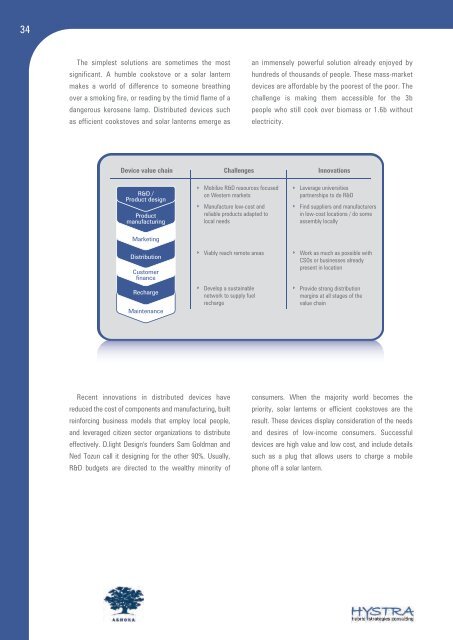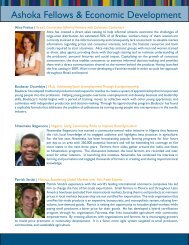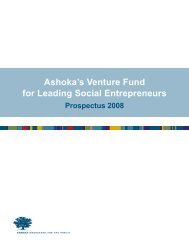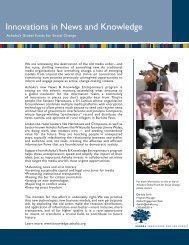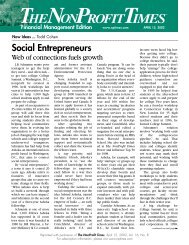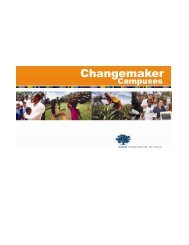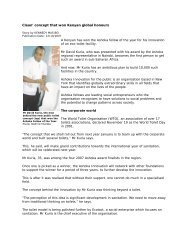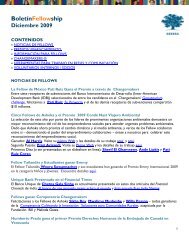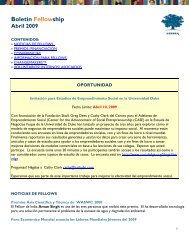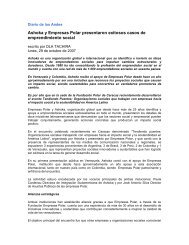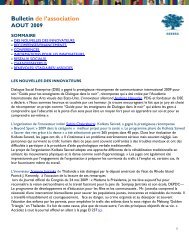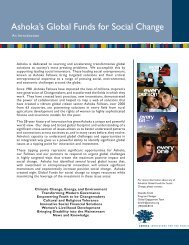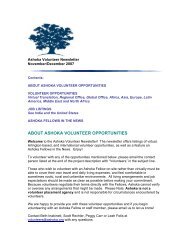Access to Energy for the Base of the - Ashoka
Access to Energy for the Base of the - Ashoka
Access to Energy for the Base of the - Ashoka
Create successful ePaper yourself
Turn your PDF publications into a flip-book with our unique Google optimized e-Paper software.
34<br />
The simplest solutions are sometimes <strong>the</strong> most<br />
significant. A humble cooks<strong>to</strong>ve or a solar lantern<br />
makes a world <strong>of</strong> difference <strong>to</strong> someone breathing<br />
over a smoking fire, or reading by <strong>the</strong> timid flame <strong>of</strong> a<br />
dangerous kerosene lamp. Distributed devices such<br />
as efficient cooks<strong>to</strong>ves and solar lanterns emerge as<br />
an immensely powerful solution already enjoyed by<br />
hundreds <strong>of</strong> thousands <strong>of</strong> people. These mass-market<br />
devices are af<strong>for</strong>dable by <strong>the</strong> poorest <strong>of</strong> <strong>the</strong> poor. The<br />
challenge is making <strong>the</strong>m accessible <strong>for</strong> <strong>the</strong> 3b<br />
people who still cook over biomass or 1.6b without<br />
electricity.<br />
Device value chain Challenges Innovations<br />
R&D /<br />
Product design<br />
Product<br />
manufacturing<br />
Marketing<br />
Distribution<br />
Cus<strong>to</strong>mer<br />
finance<br />
Recharge<br />
Maintenance<br />
�<br />
�<br />
�<br />
�<br />
Mobilize R&D resources focused<br />
on Western markets<br />
Manufacture low-cost and<br />
reliable products adapted <strong>to</strong><br />
local needs<br />
Viably reach remote areas<br />
Develop a sustainable<br />
network <strong>to</strong> supply fuel<br />
recharge<br />
Recent innovations in distributed devices have<br />
reduced <strong>the</strong> cost <strong>of</strong> components and manufacturing, built<br />
rein<strong>for</strong>cing business models that employ local people,<br />
and leveraged citizen sec<strong>to</strong>r organizations <strong>to</strong> distribute<br />
effectively. D.light Design's founders Sam Goldman and<br />
Ned Tozun call it designing <strong>for</strong> <strong>the</strong> o<strong>the</strong>r 90%. Usually,<br />
R&D budgets are directed <strong>to</strong> <strong>the</strong> wealthy minority <strong>of</strong><br />
�<br />
�<br />
�<br />
�<br />
Leverage universities<br />
partnerships <strong>to</strong> do R&D<br />
Find suppliers and manufacturers<br />
in low-cost locations / do some<br />
assembly locally<br />
Work as much as possible with<br />
CSOs or businesses already<br />
present in location<br />
Provide strong distribution<br />
margins at all stages <strong>of</strong> <strong>the</strong><br />
value chain<br />
consumers. When <strong>the</strong> majority world becomes <strong>the</strong><br />
priority, solar lanterns or efficient cooks<strong>to</strong>ves are <strong>the</strong><br />
result. These devices display consideration <strong>of</strong> <strong>the</strong> needs<br />
and desires <strong>of</strong> low-income consumers. Successful<br />
devices are high value and low cost, and include details<br />
such as a plug that allows users <strong>to</strong> charge a mobile<br />
phone <strong>of</strong>f a solar lantern.


